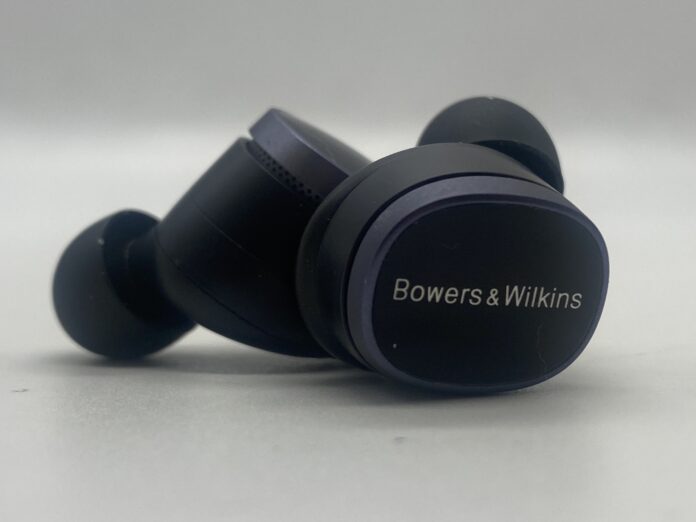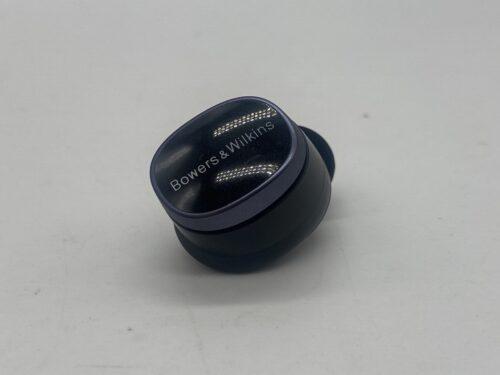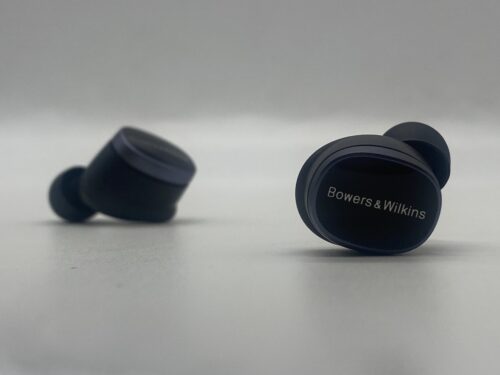Bowers and Wilkins has a crop of great wireless products and is expanding its true wireless selection with the launch of the Pi8. Previously, the Pi7 and the Pi7S2 had been the flagship for their true wireless line and they’ve come to the end of their lifecycle. With the Pi8, B&W looks to update its flagship earbuds with improved noise-canceling and lossless streaming. Should you upgrade to the Pi8?
What You Get
- Pi8
- Extra Small / Small / Medium / Large ear tips
- 60 cm USB-C to USB-C charging cable
- 80 cm 3.5 mm jack to USB-C audio cable
Look & Feel
The Pi8 has undergone a major redesign, compared to the Pi7 and Pi5. You get a completely different shell that is better at showcasing B&W’s classy aesthetic than past true wireless models. I using the anthracite back version for this review, but the midnight blue and jade green are the most stylish. There’s a shine to it that makes them very eye-catching, and B&W is almost the norm for most of their products. The only thing that’s similar to the past models is the fit. Each set of earbuds from B&W requires you to give the housing a bit of a twist when inserted in your ear. When worn correctly, the fit is quite snug, but after wearing the Pi8 for a few hours my ears were a bit fatigued, like they’d been stretched out a bit.
Design & Functionality
Inside the Pi8 are new carbon cone driver units. This is an upgrade from the Pi7 and Pi7 S2’s drivers, allowing B&W to achieve more precise tuning. This upgrade is reflected in the Pi8’s output too, which offers significantly more headroom and drive compared to past efforts. The sound reaches a comfortable gain while also appearing loud, with the potential for even more power.
The Pi8 uses touch sensors on the surface of the earbuds, and they are very responsive. Each press registers easily, with good feedback that feels close to instantaneous. Controls are one of the Pi8’s strengths, with the app letting you customize the controls as an added benefit. Noise-canceling controls are also offered in the app, where you can switch between noise-cancelation and passthrough. The noise-canceling offered on the Pi8 is quite strong, offering solid competition to some of the best on the market.
Bluetooth
While the Pi8 makes some big upgrades in terms of CODECs, I experienced some sync issues and dropouts. They happened only a few times, but it was enough to make note of as it was distracting me from my otherwise enjoyable listening time. You’ll be able to listen to the Pi8 through aptX Lossless as long as you have a compatible device, and they also feature a multipoint connection that allows you to connect the Pi8 with more than one device.
Battery Life
With a few different true wireless products coming out recently, that feature huge battery lives for way less money, it is disappointing to see that the Pi8 doesn’t make any considerable upgrades here. Although the charging case will give you fast wired and wireless charging, you can only get around 6 and a half hours from one charge.
Soundstage
I’ve heard some true wireless earbuds that feel like IEMs when it comes to soundstage, and the Pi8 joins them. It has a significantly larger scope compared to most true wireless earbuds on the market, separating the left and right channels with great balance. This clears a lot of room in the soundstage to operate with more accurate spatial imaging compared to most true wireless earbuds. Everything still feels linear, but the position of each sound appears more defined and separated from other elements. Vocals are brought forward, with layers of instruments spread out across the stereo field on a good scale.
Low End
Some of the past Bowers and Wilkins true wireless like the Pi7 have bolstered a big bass response. The Pi8 follows its previous iterations with an even more boosted tone. What separates the Pi8 from past true wireless models from the brand is its much smoother surface. The timbre still has thickness and impact, but the tone feels less bloated. It features a more organic bloom of frequencies that vibrate from underneath more than the middle. It’s a rumble that can be consistently felt, and it brings a sustained grip to every performance with even better dynamic properties.
Mids
The midrange of the Pi8 feels a lot more full compared to a lot of true wireless earbuds. Usually, you tend to hear a v-shaped sound signature that favors low-mid warmth and upper-mid clarity, but the Pi8 has more transparency. There’s good clarity across the sound spectrum, with a resolution that unfolds the more you listen. Tracks that are otherwise chaotic appear organized and precise, with notes appearing more physical than you might be used to hearing over Bluetooth earbuds.
Highs
While the highs receive the least power, their presence doesn’t go unnoticed. The Pi8 has a careful brightness that is used to portray vocals with crispness, with a smooth tail that compliments resonant details. It has a light, sparkly texture that isn’t very pronounced but feels smooth. There’s a gentleness to the highs, but they don’t forget to bring detail and clarity to the region.
Summary
The B&W Pi8 is a fantastic sound for a pair of true wireless earbuds. They’re a bit pricey at $399 but worth it for the sound quality alone. You also get strong, simple noise-canceling and lossless audio that will surely enhance your wireless music listening time. It’s not completely the upgrade I wanted in terms of battery life and connection issues, but it gets the most important aspects of a set of earbuds correct.
| Pros | Cons |
|
|
The Bowers & Wilkins Pi8 is available at Audio46.
MAJORHIFI may receive commissions from retail offers.












